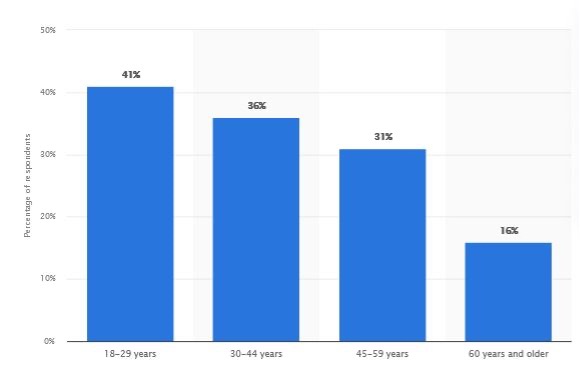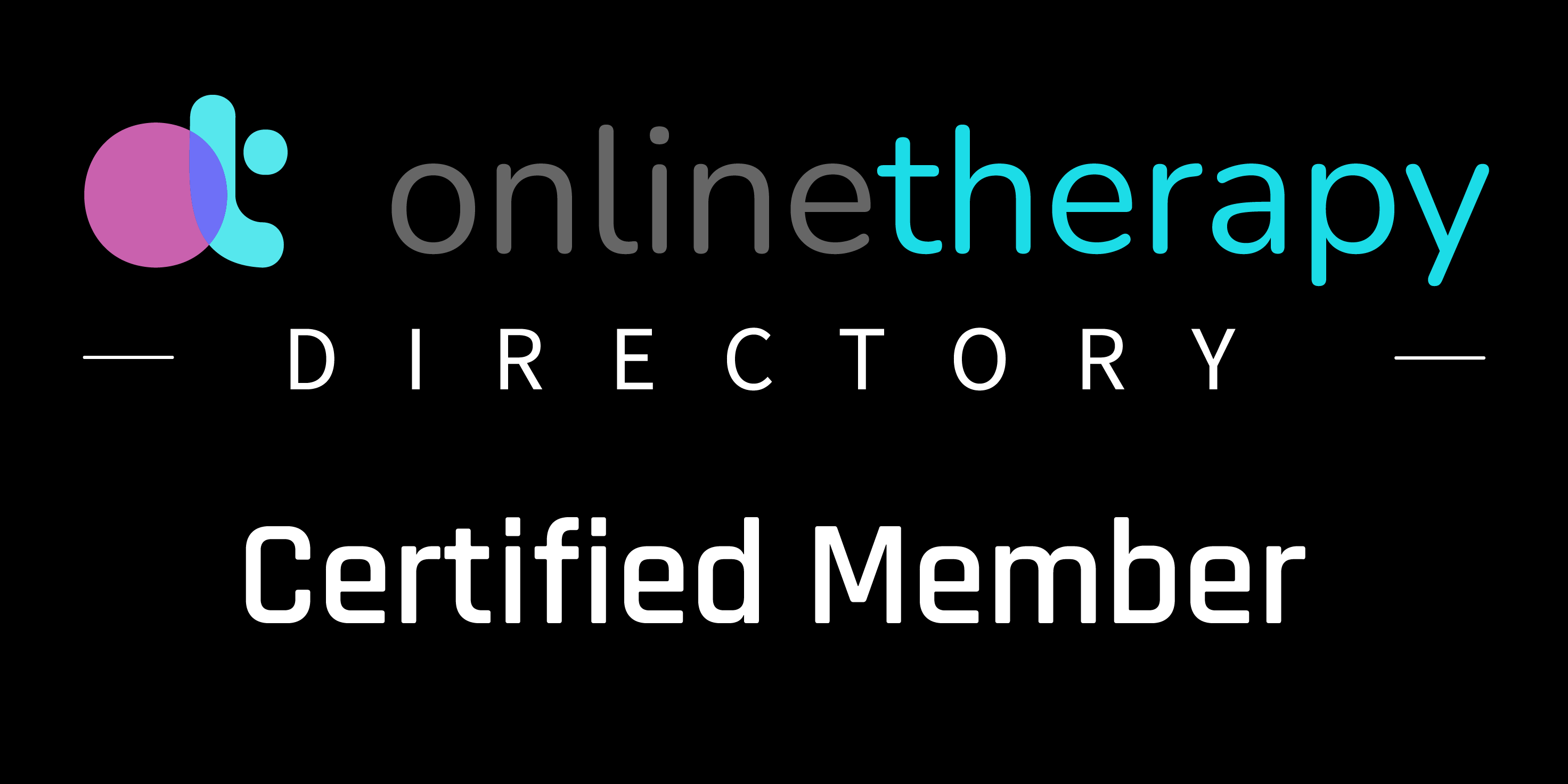
Although many of us don’t like to talk about it, anxiety disorders, like generalized anxiety, are all too common in Canada, particularly when it comes to younger Canadians.
According to data from Statista, as of 2018, 41 per cent of Canadians aged 18 to 29 had been diagnosed with some form of anxiety. And as you can see from the graph below, if you look at the data for those 30 and above, it’s not much better.

Furthermore, with all the loss, loneliness, and polarization that’s happened due to the pandemic, these issues have only been exacerbated.
A national survey published in Canadian Psychology in 2021 found that since the beginning of the pandemic, the number of respondents who reported that their anxiety was high to extremely high had quadrupled, and one-third of respondents said that their use of alcohol and/or cannabis had increased during the pandemic.
What’s more, respondents also said that they feel that both the quantity and quality of mental health support systems in Canada have decreased, and many also believe that governments in Canada should be doing more to support the mental health of Canadians.
That being said, clearly, anxiety was already a big problem in this country well before the pandemic hit, COVID has only made these problems worse, and it looks like this trend is set to continue.
These sobering statistics help to illustrate the magnitude of this problem, but we already knew all of this, and for quite some time, we’ve been well aware of how tough it can be for Canadians to afford or even access the help they need to deal with things like generalized anxiety.
At the same time, some people just don’t want to open up to a counsellor, and would rather deal with these things on their own.
With that in mind, and for the benefit of those who are struggling to access these much-needed mental health services, we wanted to publish an article offering some simple strategies that you can use to cope with generalized anxiety.
So, if you’re suffering from generalized anxiety, wondering how to deal with generalized anxiety disorder yourself, and you’re looking for advice on how to cope, then you’re going to want to keep reading.
Because in this article, we’re offering some information to give you a better understanding of generalized anxiety and recommending some strategies for coping with this affliction.
What Is Generalized Anxiety Disorder?

If you’ve already been diagnosed with this disorder, you may know the answer to this question.
But gaining a greater understanding of any mental health issues you’re facing is an integral part of overcoming these afflictions.
So, for those who aren’t already familiar with this disorder, and those who might like to learn more, we felt it was best to provide a bit of background on what it is and how this sort of thing can develop.
Generalized anxiety disorder, otherwise known as GAD, is a mental health condition characterized by excessive and persistent worry or anxiety about a variety of different situations or events.
People with GAD often find it difficult to control their worries, and their anxiety is not limited to specific triggers or situations. Instead, they may experience a constant sense of unease and apprehension that can interfere with their daily functioning and quality of life.
The intensity of the anxiety that GAD sufferers experience does vary, but it’s generally more pronounced than what would be considered a normal level of concern. Some people with this disorder will even make a point of avoiding certain situations or activities altogether to avoid triggering their anxiety.
Aside from excessive worrying, GAD can also lead to physical symptoms, such as restlessness, muscle tension, fatigue, irritability, difficulty concentrating, and sleep disturbances.
Generalized anxiety is thought to result from a complex interplay of biological, psychological, and environmental factors.
The exact causes are not fully understood, but researchers have identified several potential contributing factors, including things like genetics, imbalances in brain chemistry, dysfunction of neurotransmitters, and neurobiological factors related to the brain’s structure and function.
At the same time, it’s also believed that people with certain personality traits, like tending to interpret ambiguous situations as threatening, or those who’ve dealt with trauma-inducing environmental factors, may be more susceptible to developing generalized anxiety.
Moreover, it can also occur, at least in part, as a result of learned behaviours, which can develop as a result of growing up in an environment where excessive worrying is modeled or reinforced, for instance.
At any rate, GAD can be an incredibly debilitating disorder, not least because of the negative effect it can have on many aspects of your life, like work, relationships, social activities, and more.
Strategies for Coping with Generalized Anxiety Disorder
It’s not uncommon for people to think that the only way they can deal with their anxiety is to get professional help.
That being said, if you want to learn how to overcome generalized anxiety disorder, seeking help from a counsellor is one of the best things you can do.
But the reality is, depending on who you are and where you reside, these services aren’t always available, and for some people, they can be completely unaffordable.
What’s more, many people just aren’t comfortable speaking to a stranger about their problems, even if they are a registered clinical counsellor.
Luckily, even if you can’t access or afford counselling, or you’re hesitant about speaking to a counsellor, there’s actually a lot you can do all by yourself.
With that in mind, below, we’ve provided several strategies for coping with generalized anxiety disorder, so if need be, you can take these matters into your own hands.
For the purposes of this article, we’re focusing on tactics that apply primarily to generalized anxiety disorder, but keep in mind that these strategies can be used to cope with other forms of anxiety, as well.
Separate Yourself from the Story
One of the things that many people tend to do that can create anxiety is telling themselves anxiety-inducing stories, which are often not based in reality.
Typically, the mind will repeat these stories ad nauseum, until it becomes a kind of conditioned response to certain situations, and oftentimes, people aren’t even aware of the fact that they’re doing this.
For example, you might be afraid of flying, and so when you need to get on a plane, you’ll agonize over what could happen, telling yourself a story about the likelihood of the plane crashing, and how that might play out, until you’ve convinced yourself that you just simply can’t go.
With that said, one of the best things you can do to learn how to deal with generalized anxiety disorder, and reduce anxiety in general, is to separate yourself from these kinds of stories.
The first step in this process is to be aware of the story’s existence and recognize the fact that you’re doing this while avoiding any form of judgment.
Once you’ve accepted these things to be true, and you’re fully aware of them, then you can begin the process of separating your irrational thoughts and fears from the reality of the situation.
To do this, instead of directly challenging the story, start by remembering that it’s not based in reality, and when you catch yourself telling that story again, be mindful of the situation, and remind yourself that there are different ways of thinking about these things.
At this point, you can begin to pull back from the story, detach yourself from it, and stop being consumed by it.
Once you’ve accomplished all this, the final step is learning how to refocus your attention when you start telling yourself that story again.
So, using the example I cited above, if you’re afraid of flying, instead of getting all worked up and stressing yourself out about what might happen, you could tell yourself something like, “Yeah, I guess the plane could crash. But I’m still going to go because it’s important to me.”
This way, instead of continuing to catastrophize, you can refocus your attention on how important this is to you, and the fact that no matter what might happen, you’re still going to get on that plane, which means there’s just no point in worrying.
Stop Safety Seeking

Safety-seeking and avoidance behaviours are psychological responses that individuals often engage in to manage feelings of anxiety, fear, or distress.
This includes things like constantly seeking reassurance or validation from others, obsessively checking things like door locks to ensure they’re secure, avoiding circumstances that can cause anxiety, like social situations, along with binge eating, substance abuse, emotional suppression, procrastination, and choosing to isolate oneself.
These common yet counterproductive behaviours are intended to reduce perceived threats and create a sense of safety, even if only temporarily.
But it’s important to note that while these behaviours may provide temporary relief from anxiety or distress, they can reinforce the underlying anxiety and make it worse in the long run, while causing a litany of other problems at the same time.
Similar to separating yourself from your stories, the first step in putting a stop to safety-seeking and avoidance behaviours is to recognize these behaviours for what they are.
Once you’ve done that, and you’re actually aware of what you’re doing, then you can begin to do what we call resourcing. This term refers to finding healthy ways to calm your sympathetic nervous system, which can help you to stop safety seeking and avoiding things.
The sympathetic nervous system is responsible for the “fight or flight” response, which prepares the body to respond to stress or danger by doing things like increasing heart rate, dilating pupils, redirecting blood flow to muscles, and releasing stress hormones like adrenaline.
When you calm your sympathetic nervous system, you are essentially promoting the activity of the parasympathetic nervous system, which is responsible for the “rest and digest” response. This state helps the body relax, conserve energy, and promote healing and recovery, all of which can help to reduce your anxiety.
Luckily there are a ton of different ways to do this, including things like tapping, gratitude journaling, deep breathing, meditation and mindfulness, yoga and stretching, visualization techniques, engaging in relaxing activities, exercising, or spending time with loved ones.
By engaging in these kinds of activities, you can help balance the activity of your sympathetic and parasympathetic nervous systems, leading to a calmer and more relaxed state of being, which can help you to deal with any form of anxiety, including generalized anxiety disorder.
If you want to learn more about how to deal with anxiety as it’s happening, then you should check out our article on Finding Peace in the Chaos: How to Deal With Panic Attacks While They’re Happening.
Rick Hanson’s Positive Installation Technique
Rick Hanson is a psychologist and author known for his work on mindfulness, positive psychology, and well-being.
One of the techniques he’s developed, which is called the Positive Installation Technique, can actually be great for coping with anxiety.
This method is designed to help individuals internalize positive experiences and emotions to foster emotional well-being. Its aim is to promote the brain’s natural ability to “take in the good”, which can help to create lasting positive changes in your mental outlook.
The Positive Installation Technique involves three simple steps:
- Have a Positive Experience: Begin by intentionally engaging in or noticing a positive experience. This could be something small or ordinary, like enjoying a moment of peace, savouring a pleasant sensation, or appreciating a kind gesture.
- Savour the Experience: Once you’ve identified a positive experience, take a moment to fully savour and immerse yourself in it. Pay attention to the sensory details, emotions, and thoughts associated with the experience.
- Intentionally Absorb: This step involves consciously trying to absorb the positive experience into your mind. Imagine the positive feelings sinking into your body and mind, as if you’re allowing them to become a part of you. You might think of metaphors like soaking in warmth or letting the experience sink in like water into a sponge.
Repeating this process over time can lead to a more positive outlook and an increased sense of well-being. The brain’s neuroplasticity allows it to rewire its connections based on repeated experiences, so by intentionally focusing on positive moments, you can gradually reshape your brain’s response to the world around you.
This way, you’ll be less likely to see things in a negative light, which can help to reduce your overall anxiety, and you can also recall these experiences when you’re anxious, which can help you to deal with anxiety as it’s happening.
Are you looking for an anxiety counsellor online to help you overcome generalized anxiety disorder? Our counsellor, Paige Hollingsworth, specializes in online anxiety counselling. Contact us for more information, or book an appointment with her today.







